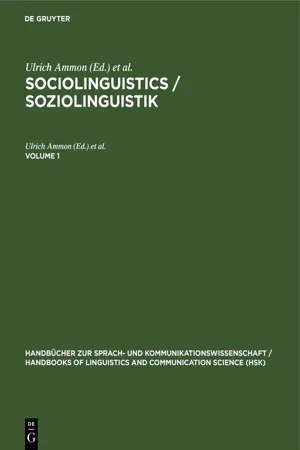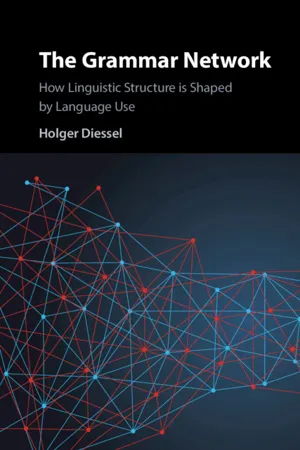Languages & Linguistics
Functional Basis of Language
The functional basis of language refers to the idea that language serves specific functions in communication, such as expressing thoughts, emotions, and intentions. This concept emphasizes the role of language in facilitating social interaction and conveying meaning. It also encompasses the idea that language structures and features have evolved to fulfill these communicative functions.
Written by Perlego with AI-assistance
Related key terms
1 of 5
7 Key excerpts on "Functional Basis of Language"
- N. J. Enfield, Paul Kockelman, Jack Sidnell(Authors)
- 2014(Publication Date)
- Cambridge University Press(Publisher)
That is, since language is fundamentally an instrumental tool, it is reasonable to assume that its structures are informed by the structure of our experience and our cultural models of experience. Functionalists take the internal organization of language to be a complex adaptive response to the ecological settings in which language is found, the interactional functions which it serves, and the full cognitive, social, and physiological properties of the human user. Functional linguistic research is aimed at clarifying the relationship between linguistic form and function, and at determining the nature of the functions which appear to shape linguistic structure, foremost among which are facilitating effective communication and assisting cognition. Functional linguistics has always included both scholars who are working on description (what languages are like) and those working on explanation (why languages are the way they are). In this chapter, we will offer a brief overview of scholarship in func- tional linguistics, and then focus on constituency, a specific problem which has attracted significant attention from functionalists. In the second part of the chapter, we will examine constituency from the per- spective of a natural outgrowth of functionalism in linguistics, namely a concern with the function of grammar in its ecological habitat, conversa- tional interaction. Prominent early proponents of a functionalist perspective include Bolinger (e.g., 1952, 1965), Firbas (e.g., 1964, 1992), Halliday (e.g., 1967– 68), and Sapir (e.g., 1921, 1949), inter alia. A community of functionalist linguists, however, didn’t begin to form until the 1970s, focused around the work of such scholars as Comrie, Dixon, and Givo ´ n.- eBook - PDF
- Edna Andrews(Author)
- 2014(Publication Date)
- Cambridge University Press(Publisher)
2 Building the basis: linguistic contributions to a theory of language and their relevance to the study of language and brain Linguistics has a double object: it is the science of language and the science of languages. (E ´ mile Benveniste) One of the ongoing issues in research devoted to language and brain is the need for a more significant incorporation of linguistic theory. Poeppel (2004, 2005, 2008) has been one of the more eloquent researchers to discuss this problem. In this chapter I take up this issue and present a set of important contributions from theoretical linguistics, cognitive linguistics, cognitive anthropology, semiotics, sociolinguistic theory, and second language acquisition theory that are central to a robust research agenda in the field of language and brain. In particular, I will analyze the essential principles of human language that are critical to the development and implementation of ecologically valid research paradigms in the study of brain and language, since many of the central notions of the discipline of linguistics have not been fully articulated and explored in neurolinguistic and imaging studies of language. 1 2.1 The foundation of a theory of language and brain: understanding speech acts In order to build a theoretical foundation for understanding human language, there are fundamental properties inherent in all human languages that must be explicated from the very beginning. One way to introduce these concepts is via an attempt at a working definition of language. I propose the following definition of language and languages as a starting point for this analysis: A learned, dynamic, hierarchical, relatively autonomous system of meaning- generating paradigmatic and syntagmatic signs that signify and communicate to self and others via speech communities and communities of practice throughout the life cycle. Several important ideas are articulated in the above definition. - Ulrich Ammon(Author)
- 2012(Publication Date)
- De Gruyter(Publisher)
Functional Aspects of Language Varieties — A Theoretical-Methodological Approach by H A R A L D HAARMANN, Helsinki (Finland) 1. Introduction: The Dilemma of Sociolinguistic Theory-Making 2. Parameters of the Functional Diversity of Linguistic Systems as Pro-vided by a General Theory 2.1. The Role of the Individual's Communicative Competence as the Central Processing Unit in Human Interaction 2.2. The Functioning of Language Varieties in Interaction 2.3. The Ecological Implications of Functional Variation 3. The Foundations of a General Theory and the Ranges Covered by Partial Theories 3.1. A Partial Theory of Standard Language Processes 3.2. A Partial Theory of Polite Speech 3.3. A Partial Theory of Prestige Values in Relation to the Use of Languages of Wider Communication 4. Conclusions and Perspectives 5. Literature (Selected) 1. Introduction: The Dilemma of Sociolinguistic Theory-Making It is generally agreed among sociolinguists that the societal functions of a language have nothing to do with its structure. Linguists share this view, and in the separation of functional from structural aspects in the study of language, they seem to find their most appropriate argument for the priority of linguistics over sociolinguistics, or even for downgrading the latter field of science as a hybrid discipline. It is a common-place that pure linguists feel responsible for the analysis of linguistic structures, whereby excluding disturbing social or cultural factors which are likely to spoil the brilliance of formalistic theories. The study of environmental factors which determine the social/societal functions of a language and which cause variation in linguistic systems, is left to the sociolinguists. This means that the task of dealing with all kinds of potential irregularities 154 Harald Haarmann which might emerge from the wide range of functional variation of a language in its natural surroundings is assigned to sociolinguistics.- eBook - PDF
- Jürgen Trabant, Sean Ward, Jürgen Trabant, Sean Ward(Authors)
- 2011(Publication Date)
- De Gruyter Mouton(Publisher)
On the subcortical bases of the evolution of language Philip Lieberman 1. Introduction Although most studies on the evolution of the neural bases of human language no longer overtly accept the tenets of phrenology, they implicitly accept the proposition that particular regions of the brain constitute the seats of language, thinking, memory, and so on. And since the very beginnings of neuroscience the neural bases of human language and cognition have focussed on the neocortex. In the past forty years, linguists adhering to Noam Chomsky's theories have equated language with syntax, hypothetically specified by an innate, cortical organ, the Universal Grammar. I shall attempt to shift the focus. I shall show that speech is perhaps the central unique aspect of human linguistic ability which also includes lexical and syntactic components, and that all of these elements are learned skills, based on a distributed neural system involving much of the brain, the Functional Language System (FLS). Neither the anatomy nor the physiology of the FLS can presently be specified with certainty. However, evidence from many behavioural and neurobiological studies suggests that the neural basis of human language is a distributed network that crucially involves subcortical structures, the basal ganglia. The evolution of functional basal ganglia can be traced back in time to animals similar to present-day frogs (Marin 1999) and their role in the acquisition of learned complex communicative behaviour appears to be similar in other mammalian species as well as in birds (Brainard and Doupe 2000). The evolution of human language, in this light, can be traced back hundreds of millions of years. However, the particular neural network that regulates human language, the FLS, appears to be a unique, derived human characteristic, differen-tiating humans from closely related species. - eBook - PDF
- Ulrich Ammon, Norbert Dittmar, Klaus J. Mattheier, Peter Trudgill, Ulrich Ammon, Norbert Dittmar, Klaus J. Mattheier, Peter Trudgill(Authors)
- 2020(Publication Date)
- De Gruyter Mouton(Publisher)
The typical linguistic features of the so-called practical and theoretical languages, actualized in technological and scientific liter-ature, coincide with what we now call lan-guage for specific purposes. — The differen-tial and functional view has been put not only in this classical shape, but also in a surprising number of creative variations. Very near to the original idea comes the Neo-Firthian con-cept of functional language types. Another attempt aims at a classification of different forms of actualization of the language system in speech. It is emphasized that a language for specific purposes is different from a socio-lect in that it is determined by the topic and not by the interest of a definite social group. — From still another point of view a language for specific purposes is nothing more than the restricted use of language in certain domains of human activity. The re-stricted variants have become known under the name of registers and characterized by their vocabularies as well as their syntax and certain stylistic phenomena. 4.3. Functional Stylistics Functional stylistics (cf. art. 38) as a relatively independent component of functional speech analysis has provided a substantial stimulus to the study of language differentiation. In-stead of functional languages, however, it examines functional styles as complexes of stylistic features at various levels, resulting from a process of selection that is determined by the author's intention, by the content and the form of his message and by the effect desired. Languages for specific purposes are in this way reduced to scientific style as a very general characterization of nearly all branches of science and technology. — The classical distinction is made between the styles of a) official communication, b) science, c) journalism, d) conversation, and e) literature. - eBook - PDF
- Erika Hoff(Author)
- 2020(Publication Date)
- Cengage Learning EMEA(Publisher)
C H A P T E R 2 Biological Bases of Language Development Language as a Human Universal • Language Creation • The Common Basis of Language Creation and Acquisition The Human Vocal Tract and Language The Human Brain and Language • Some Basic Neuroanatomy • Methods of Neurolinguistic Investigation • Localization of Language Functions in the Brain Brain Development and Language Development • An Early Left-Hemisphere Specialization for Language • The Basis of the Left-Hemisphere Specialization for Language • Neural Plasticity in Childhood The Critical Period Hypothesis • First Language Acquisition After Infancy • Second Language Acquisition • Processes Underlying Age Effects on Second Language Acquisition The Genetic Basis of Language Development • The Heritability of Individual Differences • The Genetics of Language Impairment Language and Other Species • The Natural Communication Systems of Other Species • The Acquisition of Human Language by Other Species The Origin of the Human Capacity for Language • Language as an Evolved Capacity • Language as a By-Product of Evolution Summary Key Terms Review Questions Having outlined the basic facts and major issues with respect to language acquisition, we now turn our attention to the organism that accomplishes this feat. Clearly, some unique property of humans explains why all humans talk, but dogs and gerbils never do. In this chapter, we will look for that biologically given aspect of human nature. We start with evidence that language is not only a universal characteristic of humans but also a virtually inevitable feature of human society. Next, we discuss the biological structures that underlie language, and we introduce the brain imaging techniques that have made investigation of the neural bases of language a burgeoning area of research. Then we ask whether language development displays two hallmarks of biologically based abilities: a critical period for development and heritability. - eBook - PDF
The Grammar Network
How Linguistic Structure Is Shaped by Language Use
- Holger Diessel(Author)
- 2019(Publication Date)
- Cambridge University Press(Publisher)
Functional linguists have shown that the various types of referring expressions serve particular pragmatic functions that correlate with aspects of the linguistic and nonlinguistic context (e.g., givenness, visibility) (Givón 1983; Chafe 1994). However, from a cognitive perspective we may say that speakers (often) choose a particular term based on what they think listeners know and see, and listeners interpret the chosen expressions based on the assump- tion that speakers construct sentences according to this strategy. In other words, the choice and interpretation of linguistic expressions is crucially influenced by inter- locutors’ “assessment of common ground” and the attempt to “tailor” an utterance according to “hearers’ needs” (Clark and Marshall 1981; but see §3.6). What is more, common ground and audience design do not only affect speakers’ choice of linguistic expressions, they also influence grammatical development and grammar evolution. For instance, many languages have information-structure constructions such as left-dislocation (e.g., That guy over there, he ...) and cleft- sentences (e.g., It is John who ...), which can arguably be seen as grammatical strategies that have evolved from discourse patterns that were used to establish a thematic foundation (or common ground) for the interpretation of subsequent information in the unfolding speech stream (Clark and Brennan 1991: 228). 3.4 Conceptualization Conceptualization is concerned with the construction of meaning. In (formal) semantics, linguistic meaning is commonly defined as some kind of correspondence relation between language and world, or language and thought, but in the usage- 27 Cognitive Processes and Language Use based approach, meaning is shaped by conceptualization, which is the cognitive structuring of experience or semantic content (Langacker 1987, 1991; Talmy 2000; Croft and Cruise 2004: §3). Like all other cognitive processes of language use, conceptualization is not specific to language.
Index pages curate the most relevant extracts from our library of academic textbooks. They’ve been created using an in-house natural language model (NLM), each adding context and meaning to key research topics.






